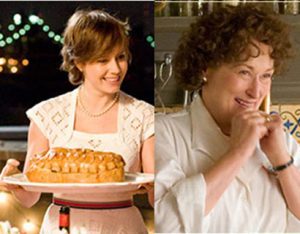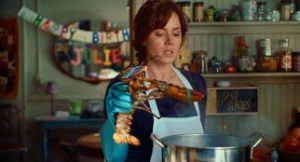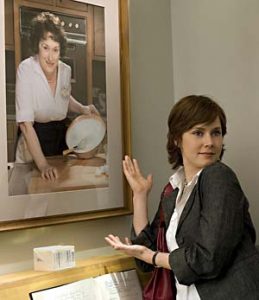 This movie juxtaposes the lives of Julia Child and Julie Powell and how they are similar and different. During this time, Julia Child is living in Paris with her husband, who works for the US government. Julia takes different classes to try and find a hobby, such as hat making or bridge playing. She decides to take up cooking because of her love for food. While in a professional cooking class, she becomes inspired to write a cookbook about French cooking for Americans. She works with two other french women to create a cookbook of authentic french recipes with a target audience of american “servantless” women. Julie Powell is living in Queens with her husband, working a difficult, middle-class job. She works in a cubicle for a government agency and handles questions and concerns in the aftermath of 9/11. She uses cooking as a way to destress and escape from her daily struggles, so she sets a goal for herself to cook all 524 recipes from Julia Child’s Mastering the Art of French Cooking in one year and to blog about her experience. The movie highlights the autonomy of both women despite their social class differences and how they achieve their different culinary goals.
This movie juxtaposes the lives of Julia Child and Julie Powell and how they are similar and different. During this time, Julia Child is living in Paris with her husband, who works for the US government. Julia takes different classes to try and find a hobby, such as hat making or bridge playing. She decides to take up cooking because of her love for food. While in a professional cooking class, she becomes inspired to write a cookbook about French cooking for Americans. She works with two other french women to create a cookbook of authentic french recipes with a target audience of american “servantless” women. Julie Powell is living in Queens with her husband, working a difficult, middle-class job. She works in a cubicle for a government agency and handles questions and concerns in the aftermath of 9/11. She uses cooking as a way to destress and escape from her daily struggles, so she sets a goal for herself to cook all 524 recipes from Julia Child’s Mastering the Art of French Cooking in one year and to blog about her experience. The movie highlights the autonomy of both women despite their social class differences and how they achieve their different culinary goals.
The gender differences and female autonomy are recurring themes throughout the  film. The common culinary stereotype is that there is male dominance in high-profile chef work, but this movie uses lead female characters to defy this idea that women cannot pursue cooking as a career. Early in the movie, there is a scene that depicts multiple powerful women eating lunch and discussing their careers. They discuss their assistants that they believe are incompetent, one woman is on the phone discussing a very large business deal to build a new parcel of buildings in Midtown New York, and one woman announces her promotion to be the Senior Vice President in charge of Corporate Publicity. This makes Julie feel inferior about her average job in a cubicle and her, but it makes her realize that she has the power to follow her dreams (10:15). One friend writes articles and blogs, which she uses to belittle Julie’s new job after her previous attempt at a writing career failed. While ranting to her husband, Julie says “I could write a book. I have thoughts” (13:07). This inspires her to begin blogging about what she truly enjoys: cooking.
film. The common culinary stereotype is that there is male dominance in high-profile chef work, but this movie uses lead female characters to defy this idea that women cannot pursue cooking as a career. Early in the movie, there is a scene that depicts multiple powerful women eating lunch and discussing their careers. They discuss their assistants that they believe are incompetent, one woman is on the phone discussing a very large business deal to build a new parcel of buildings in Midtown New York, and one woman announces her promotion to be the Senior Vice President in charge of Corporate Publicity. This makes Julie feel inferior about her average job in a cubicle and her, but it makes her realize that she has the power to follow her dreams (10:15). One friend writes articles and blogs, which she uses to belittle Julie’s new job after her previous attempt at a writing career failed. While ranting to her husband, Julie says “I could write a book. I have thoughts” (13:07). This inspires her to begin blogging about what she truly enjoys: cooking.
 Another important theme throughout this film is social class. Julia Child is a member of high class society with the resources to take up any hobby she pleases. While living in Paris, she says “wives don’t do anything here… that’s not me” (20:58). She breaks the typical gender stereotype of women in France at this time by pursuing new activities and possible careers. She sees an advertisement on a bulletin board for hat making lessons, so she tries that first. Next, she tries bridge lessons. After not enjoying either of these activities, she decides to sign up for a cooking class. Her availability of resources due to a more disposable income is exemplified in the scene where Julia is signing up for the class. She tells the secretary that she was hoping for a more advanced class, but the woman replies that Julia is not an advanced cook. She tells Julia that there is one other class, but it is for professionals and that Julia will not like it. She says, “it is for professionals, which you will never be. All men, all GIs, and very expensive. I cannot imagine that you would ever want to pay the tuition.” Julia replies with, “how much?” and she begins the class immediately (32:00). This scene shows the opportunities that are available to people with money, while people like Julie Powell would not have access to this type of class. It also taps into the defiance of gender stereotypes, as Julia is the only woman in the class. The men belittle her skills, so Julia begins practicing at home so that her skills are equal to or better than the male students. On the contrary, Julie spends more money than is usual or feasible for her while preparing meals from Julia’s cookbook. Her goal to cook all 524 recipes in 365 days is daunting, especially considering the high speed of her life. Julie is a working middle-class woman in a government job, who does not always work consistent hours. She thinks this goal may be crazy due to the fact that there are days where she does not get home from work until 7 or 8pm. However, she commits to the challenge anyway as a way to escape from the struggles and stress of her daily life.
Another important theme throughout this film is social class. Julia Child is a member of high class society with the resources to take up any hobby she pleases. While living in Paris, she says “wives don’t do anything here… that’s not me” (20:58). She breaks the typical gender stereotype of women in France at this time by pursuing new activities and possible careers. She sees an advertisement on a bulletin board for hat making lessons, so she tries that first. Next, she tries bridge lessons. After not enjoying either of these activities, she decides to sign up for a cooking class. Her availability of resources due to a more disposable income is exemplified in the scene where Julia is signing up for the class. She tells the secretary that she was hoping for a more advanced class, but the woman replies that Julia is not an advanced cook. She tells Julia that there is one other class, but it is for professionals and that Julia will not like it. She says, “it is for professionals, which you will never be. All men, all GIs, and very expensive. I cannot imagine that you would ever want to pay the tuition.” Julia replies with, “how much?” and she begins the class immediately (32:00). This scene shows the opportunities that are available to people with money, while people like Julie Powell would not have access to this type of class. It also taps into the defiance of gender stereotypes, as Julia is the only woman in the class. The men belittle her skills, so Julia begins practicing at home so that her skills are equal to or better than the male students. On the contrary, Julie spends more money than is usual or feasible for her while preparing meals from Julia’s cookbook. Her goal to cook all 524 recipes in 365 days is daunting, especially considering the high speed of her life. Julie is a working middle-class woman in a government job, who does not always work consistent hours. She thinks this goal may be crazy due to the fact that there are days where she does not get home from work until 7 or 8pm. However, she commits to the challenge anyway as a way to escape from the struggles and stress of her daily life.
Finally, culinary tourism is a present theme in this film. Culinary tourism is defined as the crossing of cultural boundaries and the participation in other foodways. This can reinforce the “us” versus “them” ideology, or it can blend the cultures. Julia Child attempts to blend the French and American cultures by experiencing the French culture and attempting to transmit it back to American cooks. She wants to make this “outsider food” available to middle-class, “servantless” Americans. At first, her book is rejected for publishing because it was considered too long for a typical housewife, but Julia’s goal was to provide as much cultural culinary knowledge as possible. She did revise the cookbook and it was published, but in a slightly condensed version.  After the book is published, Julia continues to spread her culinary knowledge to others through television cooking shows. Julie falls into the target audience of the cookbook; she is a busy, servantless woman who wants to spice up her life by cooking extraordinary meals. These meals make her feel closer to Julia and the readers of Julie’s blog. Cooking these meals, which she does alone or with her husband, has still connected her to an internet community and beyond.
After the book is published, Julia continues to spread her culinary knowledge to others through television cooking shows. Julie falls into the target audience of the cookbook; she is a busy, servantless woman who wants to spice up her life by cooking extraordinary meals. These meals make her feel closer to Julia and the readers of Julie’s blog. Cooking these meals, which she does alone or with her husband, has still connected her to an internet community and beyond.

Julia and Julie both achieve their respective goals of publishing a cookbook and preparing all of the recipes in a cookbook for a blog. Julie is offered book deals after she completes her blog and both women are seen as exceedingly successful. Their parallel stories show the autonomy of women and the benefits of culinary tourism across social classes.